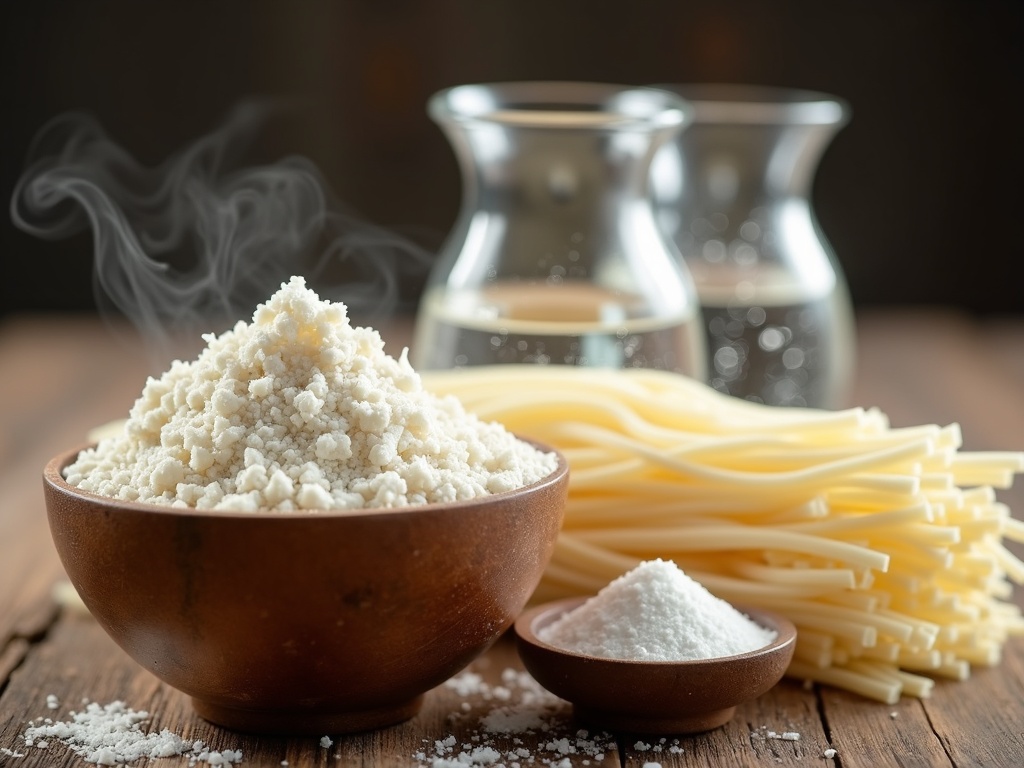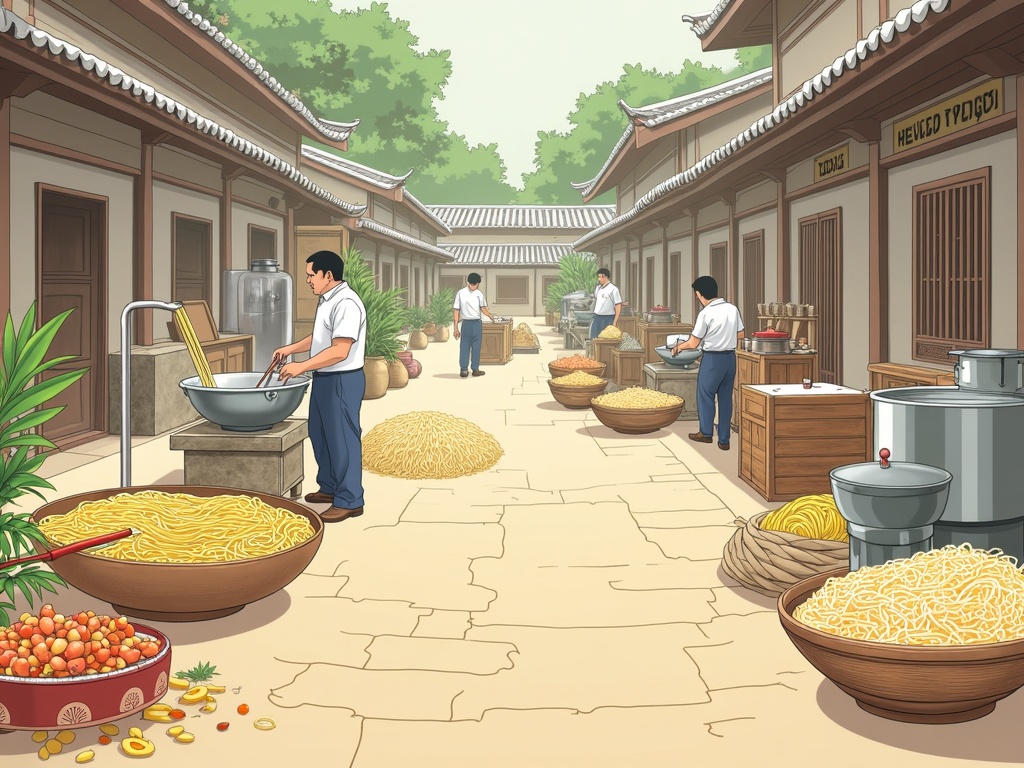Vietnamese rice vermicelli may appear simple, but its composition and production reflect centuries of culinary tradition, transforming basic ingredients into a staple of Vietnamese cuisine.
Key Takeaways
- Rice vermicelli is made primarily from long-grain rice flour with 22–28% amylose content, water, and optional tapioca starch. Tapioca may be added in a ratio of 1 part tapioca to 4–5 parts rice flour to enhance texture.
- The production process includes several stages: soaking the rice for 6–8 hours, wet-milling it into a slurry, heating to form a dough, extruding it through 1–1.5mm holes into boiling water, and rapidly cooling it in cold water baths.
- There are six traditional varieties of rice vermicelli, including fresh vermicelli, dried vermicelli, tangled vermicelli, vermicelli sheets, thick Bún Bò Huế noodles, and large woven vermicelli mats.
- Nutritionally, rice vermicelli is naturally gluten-free and contains 130–150 calories per 100g serving. It provides 28–32g of carbohydrates, 1–2g of protein, and less than 1g of fat.
- In terms of appearance, rice vermicelli stands out with its thin cylindrical strands and opaque white color. It differs from flat bánh phở, transparent mung bean miến noodles, and yellow wheat-based mì noodles.
The Core Components: Rice, Water, and Starch
Rice flour forms the foundation of every strand of rice vermicelli. I use finely milled rice flour, specifically from long-grain rice varieties, because they contain higher amylose content typically ranging from 22–28%. This higher amylose concentration creates firmer, less sticky noodles that maintain their shape beautifully in hot soups and cold salads alike. Short-grain rice contains more amylopectin, which makes it stickier and better suited for rice cakes rather than noodles.
Essential Liquid and Starch Components
Water serves as the second crucial ingredient, creating the initial slurry and facilitating the cooking process. The purity and temperature of water directly impacts the final noodle quality, so I always ensure clean, filtered water reaches the proper temperature before mixing.
Tapioca starch represents the third component that many manufacturers add to enhance texture. This optional ingredient transforms the noodle’s characteristics significantly:
- Creates a chewier, more elastic texture known as “dai” in Vietnamese cuisine
- Produces a slightly more translucent appearance compared to 100% rice flour noodles
- Typically mixed in ratios of 1 part tapioca starch to 4 or 5 parts rice flour
- Enhances the noodle’s ability to absorb flavors from broths and sauces
Natural Gluten-Free Properties
Rice vermicelli naturally contains zero gluten, making it an excellent choice for people with celiac disease or gluten sensitivities. Unlike wheat-based noodles, rice vermicelli provides a safe alternative without compromising on taste or versatility. I find this particularly valuable when preparing dishes like Vietnamese rice vermicelli with grilled pork, where the noodles must complement bold flavors while remaining light and digestible.
The combination of these simple ingredients creates remarkably versatile noodles. When considering what to make with rice vermicelli for family meals, the neutral flavor profile allows these noodles to pair with virtually any protein, vegetable, or sauce combination. Their clean taste makes them perfect for both traditional Asian dishes and fusion creations.
Quality rice vermicelli depends entirely on the balance between these components. Premium brands carefully control the rice flour quality and tapioca starch ratios to achieve consistent texture and cooking performance. For those exploring healthy options with rice vermicelli, the minimal ingredient list ensures you’re getting pure, wholesome nutrition without artificial additives or preservatives.

The Production Process: From Rice to Noodle
Creating rice vermicelli follows a traditional yet precise process that transforms simple rice grains into delicate, translucent noodles. I’ll walk you through each critical step that professional noodle makers use to achieve the perfect texture and consistency.
Initial Preparation and Dough Creation
The process begins with soaking whole rice grains for 6–8 hours until they soften completely. Once adequately hydrated, the grains undergo wet-milling to create a very fine, smooth, watery slurry. This grinding stage determines the final texture quality of your noodles.
Following the grinding, I heat the slurry gently while stirring constantly until it thickens into a pliable, sticky dough. This step achieves partial gelatinization of the starch, which gives the noodles their characteristic chewy texture. Getting the consistency right during this phase is crucial for successful extrusion.
Extrusion and Final Processing
The transformation from dough to noodle happens through extrusion. I load the prepared dough into a press equipped with a perforated plate, then force it through tiny holes measuring 1–1.5 mm in diameter directly into boiling water. The immediate contact with hot water begins the cooking process instantly.
The cooking stage requires precise timing. Extruded noodle strands cook for only 1–2 minutes in the boiling water before I transfer them to a cold water bath. This entire cooking process can be as brief as 60 seconds. The cold water shock serves two essential purposes:
- It stops the cooking process immediately to prevent mushiness
- It rinses off excess surface starch to avoid clumping
Traditional production methods rely on large stone grinders and manual hand-crank presses, techniques passed down through generations. Modern industrial facilities use stainless steel machinery for milling, cooking, and hydraulic extrusion to ensure consistency and enable mass production.
Famous “noodle villages” across Vietnam have perfected this craft over centuries. Phú Đô in Hanoi and locations in Cần Thơ within the Mekong Delta have specialized in making rice vermicelli for generations, maintaining traditional techniques while adapting to modern demands.
Understanding this production process helps explain why quality rice vermicelli has such a distinctive texture and why it works so well in dishes like Vietnamese rice vermicelli with grilled pork. The careful balance of starch gelatinization, precise cooking times, and rapid cooling creates noodles that hold their shape while absorbing flavors beautifully. Whether you’re exploring family meal options or considering healthy preparations, knowing how these noodles are made enhances your appreciation for their versatility.
Varieties of Vietnamese Rice Vermicelli
Vietnamese rice vermicelli comes in six distinct varieties, each specifically crafted for different culinary applications. I’ll guide you through these traditional forms that showcase the versatility of this essential ingredient.
Traditional Forms and Their Culinary Uses
The most commonly encountered varieties include these specific preparations:
- Bún Tươi (Fresh Vermicelli) – This soft, moist variety arrives in pre-portioned bundles called con bún and maintains peak quality for only 1-2 days. Its delicate texture makes it perfect for Bún Riêu Cua, where the gentle strands absorb the crab-tomato broth beautifully.
- Bún Khô (Dried Vermicelli) – The dehydrated, brittle version offers extended storage capabilities and convenience. You’ll find this packaged variety in most Asian grocery stores, ready to be rehydrated for various dishes.
- Bún Rối (Tangled Vermicelli) – Presented in an appealing nest-like shape, this thin vermicelli excels in Northern Vietnamese cuisine, particularly in the famous Bún Chả where its tangled form captures the savory dipping sauce effectively.
- Bún Lá (Vermicelli Sheets) – Fresh vermicelli pressed into small, flat, leaf-like pads creates this unique variety. These delicate sheets pair exceptionally well with mắm tôm (fermented shrimp paste), offering a distinctive textural experience.
- Bún Bò Huế – This substantially thicker variety features a 2.5–3mm diameter, roughly double that of standard bún. Its robust construction withstands the intensity of the spicy soup it’s named after, maintaining structural integrity throughout the meal.
- Bánh Hỏi (Woven Vermicelli Mats) – The most intricate variety requires specialized extruders with pin-sized holes to create extremely thin, thread-like strands. These delicate threads are woven into beautiful mats, then steamed and often enhanced with scallion oil. You’ll frequently encounter this as Bánh Hỏi Chạo Tôm, where the fine texture complements grilled shrimp paste perfectly.
Each variety demonstrates how Vietnamese cuisine adapts this basic rice ingredient to specific dishes. Understanding these distinctions helps you select the appropriate type for authentic Vietnamese rice vermicelli preparations. Fresh varieties demand immediate use but offer superior texture, while dried forms provide convenience for family meal planning. The specialized shapes and thicknesses reflect centuries of culinary refinement, ensuring each dish achieves its intended flavor and textural balance.
Nutritional Profile and Comparison with Other Asian Noodles
Macronutrient Breakdown and Health Benefits
Rice vermicelli consists primarily of carbohydrates with minimal fat and protein content. A 100-gram serving of cooked rice vermicelli delivers approximately 130-150 calories, 28-32 grams of carbohydrates, 1-2 grams of protein, and less than 1 gram of fat.
I find rice vermicelli’s greatest nutritional advantage lies in what it doesn’t contain. These noodles are naturally free of gluten, cholesterol, and sodium before any seasonings are added. This makes them an excellent choice for people with celiac disease or gluten sensitivities.
The noodles function as a neutral carbohydrate base, designed to carry bold flavors from broths and complement nutrient-dense ingredients. When you prepare rice vermicelli dishes, you typically add lean proteins like chicken, pork, tofu, or shrimp alongside fresh herbs and vegetables such as lettuce, mint, bean sprouts, and cilantro. This combination creates a nutritionally balanced meal where the vermicelli provides energy while other ingredients supply essential vitamins, minerals, and protein.
How Rice Vermicelli Differs from Other Asian Noodles
Understanding the differences between rice vermicelli and other Asian noodles helps you choose the right noodle for specific dishes. Rice vermicelli (bún) differs significantly from bánh phở noodles, despite both being made from rice flour. Bún has a thin, cylindrical shape, while bánh phở appears flat, wide, and rectangular like fettuccine. You’d never substitute round bún in traditional phở soup.
Miến (cellophane or glass noodles) presents another distinct option. While bún uses rice flour and remains opaque white when cooked, miến comes from mung bean starch, creating transparent, “glassy” noodles with a slippery, elastic texture. Cellophane noodles absorb significantly more liquid than rice noodles, making them ideal for dishes like Miến Gà (Chicken Glass Noodle Soup).
Mì (egg or wheat noodles) represents the most nutritionally different option. Made from wheat flour and often containing eggs, mì noodles display a distinctive yellow color and springy texture. They contain gluten and offer higher protein content (5-7 grams per 100 grams cooked) compared to rice vermicelli’s 1-2 grams. These wheat-based noodles work perfectly in dishes like Mì Hoành Thánh (Wonton Noodle Soup). For those seeking healthy rice vermicelli options, the naturally gluten-free nature and lower calorie content make it an appealing choice for various dietary needs.


